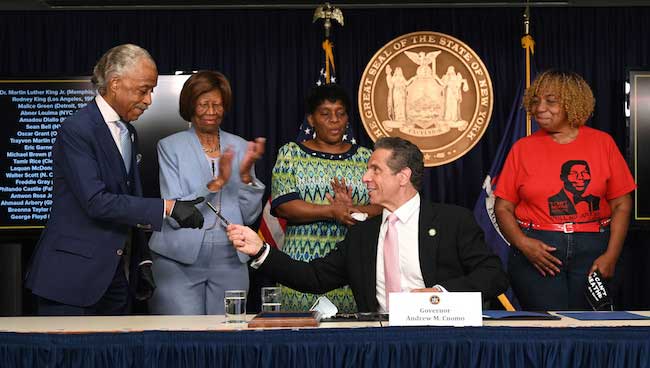Cuomo requires every law enforcement agency to adopt reform plan by April 1
Plans must include policies for use of force, crowd management, community policing, implicit bias awareness and de-escalation training, restorative justice practices, community outreach, and a transparent citizen complaint procedure
Gov. Andrew Cuomo signed a new executive order on Friday that requires all law enforcement agencies in the state to adopt plans for community policing.
Those plans need citizen input and must be adopted by April 1, or that department could lose its state.
Cuomo’s executive order is called the New York State Police Reform and Reinvention Collaborative. It mandates all of the state’s roughly 500 law enforcement agencies must discuss with the community if policing strategies need to be reinvented.
“Our law enforcement officers are essential to ensuring public safety — they literally put themselves in harm’s way every day to protect us,” Cuomo said. “This emergency regulation will help rebuild that confidence and restore trust between police and the communities they serve by requiring localities to develop a new plan for policing in the community based on fact-finding and meaningful community input.”
Cuomo said some communities make be happy with how their law enforcement agencies are currently functioning. Those departments need to affirm that response from the community and send that as a plan to the state.
Other communities may want significant changes in how a department operates, including with the number of officers, equipment and the allocation level of tax dollars used to fund that department.
“The protests taking place throughout the nation and in communities across New York in response to the murder of George Floyd illustrate the loss of community confidence in our local police agencies — a reality that has been fueled by our country’s history of police-involved deaths of black and brown people,” Cuomo said.
Cuomo, speaking today at a news conference, said a village or city mayor may drive the process for the plan and getting citizen input, or a County Legislature leader, council president or Public Safety chairman could take the lead.
Cuomo wants frank discussions among communities and the law enforcement agencies, and a clear understanding of the impact to the local taxpayer for the police.
Cuomo said the following need to happen for a law enforcement agency to be in compliance with the executive order:
Police forces must adopt a plan by April 1, 2021 to be eligible for future state funding and certify that they have:
- Engaged stakeholders in a public and open process on policing strategies and tools;
- Presented a plan, by chief executive and head of the local police force, to the public for comment;
- After consideration of any comments, presented such plan to the local legislative body (council or legislature as appropriate) which has approved such plan (by either local law or resolution); and
- If such local government does not certify the plan, the police force may not be eligible to receive future state funding.
The governor has signed about 10 executive orders regarding the police since the death of George Floyd on Memorial Day.
Cuomo’s “Say Their Name” agenda includes allowing for transparency of prior disciplinary records of law enforcement officers by reforming 50-a of the civil rights law; banning chokeholds by law enforcement officers; prohibiting false race-based 911 reports and making them a crime; and designating the Attorney General as an independent prosecutor for matters relating to the deaths of unarmed civilians caused by law enforcement.
Cuomo said the demonstrations have already led to changes in policing.
“All the great activists in history will tell you protest is a means to an end,” he said today. “The end is change, the end is reform. Protest is not for the sake of protest. Demonstrations are not for the sake of demonstrations. It’s to make a point, it’s to communicate, it’s to get attention, and then it’s actually make change.”
The New York State Police Reform and Reinvention Collaborative ‘s a “game changer” that will serve as a national model, Cuomo said.
“Every community in this state gets to redesign its police department,” he said. “Every community in this state gets to determine what is the appropriate public safety function in 2020.”
Cuomo said many law enforcement agencies don’t have the trust and respect of the communities they serve.
He expects to see communities develop different plans for police departments, which range in size from one officer to 38,000 with the New York City Police Department.
“There is no such thing as a statewide police department, that’s the state police,” Cuomo said. “Every community has its own police department, its own wants, its own needs … Different communities have different needs. They have different opinions. They have different ideas. Fine, make the police department work for you, but do it. Do it.”
Cuomo said it’s now up to the community leaders across the state, law enforcement officials, activists and other citizens to get together.
The plans must address the law enforcement agency’s use of force, crowd management, community policing, implicit bias awareness and de-escalation training, restorative justice practices, community outreach, a transparent citizen complaint procedure and other issues specific to each community, Cuomo said.
“It now requires real leadership, not just criticism, not just suggestions,” Cuomo said. “You need a real leader or number of people to lead and actually make this happen.”






































































